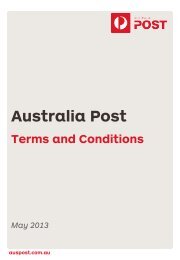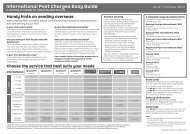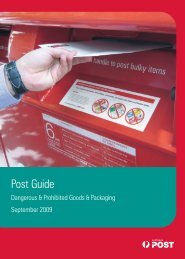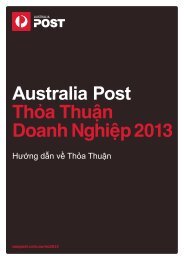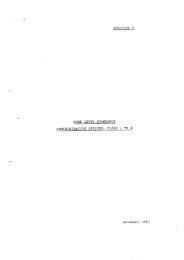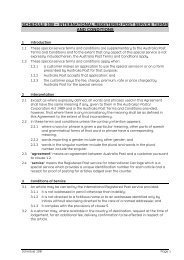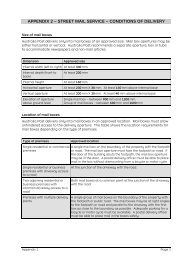2004-05 Annual Report - Australia Post
2004-05 Annual Report - Australia Post
2004-05 Annual Report - Australia Post
Create successful ePaper yourself
Turn your PDF publications into a flip-book with our unique Google optimized e-Paper software.
NOTES TO AND FORMING PART OF THE FINANCIAL STATEMENTS<br />
01. SUMMARY OF SIGNIFICANT ACCOUNTING POLICIES<br />
(a) Basis of accounting<br />
The <strong>Australia</strong>n <strong>Post</strong>al Corporation (the corporation)<br />
is incorporated under the provisions of the <strong>Australia</strong>n<br />
<strong>Post</strong>al Corporation Act 1989 as amended. Financial<br />
statements are required by clause 1(b) of Schedule<br />
1 to the Commonwealth Authorities and Companies<br />
Act 1997.<br />
This is a general-purpose financial report prepared<br />
in accordance with:<br />
° Finance Minister’s Orders (being the<br />
Commonwealth Authorities and Companies<br />
(Financial Statement) Orders) for reporting periods<br />
ending on or after 30 June 20<strong>05</strong><br />
° <strong>Australia</strong>n Accounting Standards and Accounting<br />
Interpretations issued by the <strong>Australia</strong>n Accounting<br />
Standards Board<br />
° Consensus Views of the Urgent Issues Group.<br />
The Corporation and Consolidated Statements of<br />
Financial Performance and Financial Position are<br />
prepared on an accrual basis and are in accordance<br />
with the historical cost convention, except for certain<br />
assets which, as noted, are at valuation. Except<br />
where stated, no allowance is made for the effect of<br />
changing prices on the results or the financial position.<br />
Accounting policies adopted are consistent with those<br />
applied in the prior year.<br />
Assets and liabilities are recognised in the Corporation<br />
and Consolidated Statements of Financial Position<br />
when and only when it is probable that future<br />
economic benefits will flow and the amounts of the<br />
assets or liabilities can be reliably measured. Liabilities<br />
and assets that are unrecognised are reported in<br />
the Schedule of Commitments and the Schedule of<br />
Contingencies (other than unquantifiable or remote<br />
contingencies, which are reported at note 39).<br />
Revenues and expenses are recognised in the<br />
Corporation and Consolidated Statements of<br />
Financial Performance when and only when the flow<br />
or consumption or loss of economic benefits has<br />
occurred and can be reliably measured.<br />
Comparative information is reclassified where<br />
appropriate to achieve consistency in disclosure<br />
with current financial year amounts and other<br />
disclosures. Amounts shown in the financial<br />
statements have been rounded to the nearest<br />
one hundred thousand dollars except in relation<br />
to remuneration of directors, remuneration of<br />
executives and remuneration of auditors.<br />
(b) Principles of consolidation<br />
The consolidated financial statements comprise the<br />
corporation (parent entity) and its controlled entities.<br />
The financial statements of the controlled entities are<br />
prepared using accounting policies consistent with<br />
those of the corporation. The effects of transactions<br />
and balances between the entities are eliminated in<br />
full. Results of controlled entities are consolidated<br />
from the time control is obtained until it ceases.<br />
(c) Revenue recognition<br />
(i) Sales revenue<br />
Sales revenue comprises revenue earned (net of<br />
returns, discounts and allowances) from the major<br />
FOR THE YEAR ENDED 30 JUNE 20<strong>05</strong><br />
business activities. Recognition is at point of sale in<br />
the case of postage items and provision of agency<br />
services, point of lodgement in the case of bulk mail<br />
and when control of goods has passed to the buyer in<br />
the case of retail products. Allowance is made for the<br />
assessed amount of revenue from postage sales as at<br />
balance date in respect of which service had not yet<br />
been provided (refer note 17).<br />
(ii) Interest revenue<br />
Interest revenue is recognised when control of<br />
the right to receive the interest payment has been<br />
established.<br />
(iii) Government funding<br />
Funding from Government for specific activities is<br />
recognised when control of the right to receive the<br />
funding has been established.<br />
(iv) Asset sales<br />
Sales of property are generally recognised on<br />
exchange of title. However, in certain circumstances<br />
when there is a contractual obligation to complete a<br />
property sale and settlement is assured, the sale is<br />
recognised when the underlying contract becomes<br />
unconditional. Revenue from the sale of non-property<br />
assets is recognised when control of the asset has<br />
passed to the buyer.<br />
(v) Dividends<br />
Dividends are recognised when control of the right to<br />
receive a dividend has been established. Dividends<br />
received from joint-ventures are accounted for in<br />
accordance with the equity method of accounting.<br />
(d) Depreciation and amortisation<br />
Depreciable property, plant and equipment assets<br />
are written-off to their estimated residual values over<br />
their estimated useful lives to the corporation using<br />
the straight-line method of depreciation.<br />
Depreciation/amortisation rates (useful lives)<br />
and methods are reviewed annually and necessary<br />
adjustments are recognised in the current, or current<br />
and future reporting periods, as appropriate. Residual<br />
values are re-estimated for a change in prices only<br />
when assets are revalued.<br />
Depreciation and amortisation rates applying to items<br />
in each class of depreciable asset are based on the<br />
following useful lives:<br />
20<strong>05</strong> <strong>2004</strong><br />
Buildings – GPOs 70 years 70 years<br />
Buildings –<br />
other facilities<br />
Leasehold<br />
improvements<br />
40–50 years 40–50 years<br />
Lower of<br />
lease term<br />
and 10 years<br />
Lower of<br />
lease term<br />
and 10 years<br />
Motor vehicles 3–7 years 3–7 years<br />
Specialised plant<br />
and equipment<br />
10–20 years 10–20 years<br />
Other plant and equipment 3–10 years 3–10 years<br />
The aggregate amount of depreciation and<br />
amortisation allocated for each class of asset<br />
during the reporting period is disclosed in note 3.<br />
<strong>Australia</strong> <strong>Post</strong> <strong>Annual</strong> <strong>Report</strong> <strong>2004</strong>/<strong>05</strong> Financial and Statutory <strong>Report</strong>s Notes to and forming part of the financial statements<br />
| 69 |




